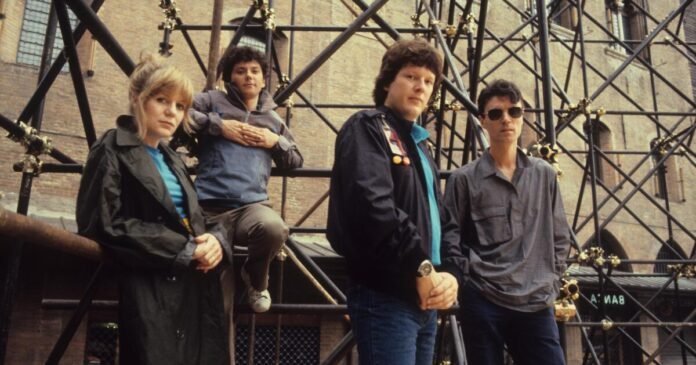Book Review
Burning Down the House: Talking Heads and the New York Scene That Transformed Rock
By Jonathan Gould
Mariner Books: 512 pages, $35
If you buy books linked on our site, The Times may earn a commission from Bookshop.org, whose fees support independent bookstores.
When an author decides to tackle the story of a popular and important band like Talking Heads, the contours of which are familiar to many of its fans, the remit should be to illuminate the unexplored corners, the hidden details and anecdotes that provide a more full-bodied narrative and ultimately bring the band into sharper relief than ever before. Unfortunately, Jonathan Gould has almost completely ignored this directive in “Burning Down the House,” his new Talking Heads biography. This lumpy book, full of redundant stories and unnecessary detours that provide little illumination but plenty of needless bulk, lacks participation by the group’s members and is not the biography that this great and important band deserves.
As fans of the Heads already know, three of the four members met as students at the Rhode Island School of Design in the mid-’70s, children of privilege with artsy aspirations and not much direction. David Byrne came from Baltimore by way of Scotland, a socially awkward dabbler in conceptualist experiments with photography and a veteran of various mediocre cover bands. It was drummer Chris Frantz who enlisted Byrne to join one such band; bassist Tina Weymouth, Frantz’s girlfriend and the daughter of a decorated Navy vice admiral, played bass. They were an anti-jam band and pro-avant; the first decent song they came up with was a shambolic version of what became “Psycho Killer,” with Weymouth contributing the French recitatif in the song’s bridge.

For the emergent Heads, timing was everything. When Frantz signed the lease on a spacious loft on Chrystie Street in East Village in October 1974, he had unwittingly found the practice space where the three musicians would hone their craft. The loft was also a short walk to CBGB, soon to become the proving ground of New York’s punk revolution and the Heads’ primary live performance venue at the start of their career.
In March 1975, Byrne, Weymouth and Frantz attended a gig by Boston’s Jonathan Richman and the Modern Lovers at the Kitchen, an arts collective space in Soho, and it showed them a new way to approach their music. Richman, “who dressed like a kid that everyone laughed at in high school,” influenced the band’s preppy visual template and Byrne’s clenched singing voice. Within a year of moving to the city, Talking Heads had found its look, sound and favored club. When Frantz bumped into Modern Lovers bassist Ernie Brooks in a West Village Cafe, Frantz inquired about keyboardist Jerry Harrison; Brooks gave him Harrison’s number, Harrison joined the band and the classic Talking Heads lineup was complete.
What followed was a contract with Seymour Stein’s label Sire and the band’s collaboration with producer Brian Eno, beginning with its second album, “More Songs About Buildings and Food.” By the time the band released 1980’s groundbreaking “Remain in Light,” Eno’s role had expanded beyond his production duties. He was now writing songs with Byrne, which created friction within the band. When Byrne allegedly reneged on songwriting credits (the album listed “David Byrne, Brian Eno and Talking Heads,” rather than the individual band members), it created a rift that never healed, even as the band was selling millions of copies of its follow-up “Speaking in Tongues” and the soundtrack to the Jonathan Demme concert film “Stop Making Sense.” The final act was recriminatory, as Byrne commanded an ever greater share of the spotlight while the other members quietly seethed. The band’s final album, “Naked,” was its weakest, and Talking Heads dissolved in 1991, after Byrne removed himself from the lineup to explore outside projects.

Author Jonathan Gould
(Richard Edelman)
Gould does a serviceable job of telling the Heads’ story in a book that arrives 50 years after the band’s first gig at CBGB. Curiously, for someone who has tasked himself with explaining Manhattan’s late ‘70s downtown renaissance, Gould regards many of the key players in that scene with derision bordering on contempt. Gould refers to Richard Hell, a prime architect of New York punk, as a mediocrity whose “singing, songwriting and bass playing remained as pedestrian as his poetry.” Patti Smith’s music “verged on a parody of beat poetry,” while the vastly influential Velvet Underground, a band that made New York punk possible, is hobbled by its “pretensions to hipness, irony and amorality.” Even Chris Frantz’s drumming is “exceptionally unimaginative.” Gould is also careless with his descriptors. Jonathan Richman’s band displays a “willful lack” of commercial instinct, the Heads assert a “willful conventionality” to their stage appearance, Johnny Ramone is a “willfully obnoxious” guitarist and so on.
It’s hard to fathom how a biographer intent on cracking the code of one of rock’s seminal bands can do so with so much contempt for the culture that spawned it. An inquiring fan might want to go to Will Hermes’ 2011 book “Love Goes to Buildings on Fire” for a more nuanced and knowledgeable portrait of the creative ferment that made the Heads possible. As for a biography of Talking Heads, we are still left with a lacuna that Gould has unfortunately not filled.
Weingarten is the author of “Thirsty: William Mulholland, California Water, and the Real Chinatown.”






